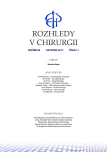History of thoracic stabilization
Authors:
M. Mašek 1; M. Kitka 2
Authors‘ workplace:
Klinika úrazové chirurgie LF Masarykovy univerzity a FN Brno
přednosta: doc. MUDr. M. Mašek, CSc.
1; Klinika úrazovej chirurgie LF Univerzity Pavla Jozefa Šafárika v Košiciach a UN L. Pasteura, Košice
prednosta: prof. MUDr. M. Kitka, CSc.
2
Published in:
Rozhl. Chir., 2017, roč. 96, č. 11, s. 453-456.
Category:
Review
Overview
The authors found 220 reports focused on the treatment of chest trauma in available literature. From external fixations, the development of methods continued to internal fixations with sophisticated plates and screws. At the same time, the so-called pneumatic internal fixation (artificial lung ventilation) was abandoned for the benefit of osteosynthetic methods (ORIF). An active surgical approach to thoracic stabilization dates back to the beginning of the 20th century. After WWII the so-called period of the first renaissance began with the introduction of internal osteosynthesis. The period of the last ten years is called the second renaissance. Today, an active early complex surgical solution is preferred, which uses implants based on the principle of stable osteosynthesis.
Key words:
stabilisation of the thorax − external fixation − ORIF − pneumatic internal fixation − timing
Sources
1. Trinkle JK, Richardson JD, Franz JL. Management of flail chest without mechanical ventilation. Ann Thoracic Surgery 1975;19:355−63.
2. Hoyt JT. An apparatus for artificial respiration and for other purposes. J Physiol. 1901;27:48−52.
3. Carter BM, Giuseffi J. Tracheostoma a useful operation in thoracic surgery with particular references to its employment in crushing injuries of the thorax. J Thorac Surg 1951;21:495.
4. Schrire T. Control of the crushed chest: the use of the “Cape Town Limpet.” Dis Chest 1963;44:141–5.
5. Beltrami V, Martinelli G, Giansante P, et al. An original technique for surgical stabilisation of traumatic flail chest. Thorax 1978; 33:528−9.
6. Guernelli N, Bragaglia R, Briccoli A, et al. Technique for the management of anterior flail chest. Thorax 1979;34:247–8.
7. Judet R. Osteosynthese costale. Rev Chir Orthop 1973;59:334–5.
8. Labitzke R, Schmit-Neuerburg K, Schramm G. Indikation zur Thoracotomie und Rippenstabilisierung beim Thoraxtrauma im hohen Lebensalter. Chirurg 1980;51: 567–80.
9. Michek J, Zelníček P, Kubačák J, et al. Včasné ošetření instabilního hrudníku u polytraumatizovaných, Rozhledy v chirurgii 1996;75:202−5.
10. Vodička J, Špidlen V, Šafránek J, et al. Schwerwiegende Brustkorbverletzungen – Erfahrungen mit der operativen Behandlung. Zentralbl Chir 2007;132: 542–6.
11. Vyhnánek F, Jirava D, Očadlík M, et al. Chirurgická stabilizace u blokové zlomeniny žeber: indikace, technika a výsledky. Acta Chir orthop Traum čech 2015;82:303–7.
Vzhledem k množství literatury k tématu je tato k dispozici u autorů.
Labels
Surgery Orthopaedics Trauma surgeryArticle was published in
Perspectives in Surgery

2017 Issue 11
- Metamizole vs. Tramadol in Postoperative Analgesia
- Metamizole at a Glance and in Practice – Effective Non-Opioid Analgesic for All Ages
- Possibilities of Using Metamizole in the Treatment of Acute Primary Headaches
Most read in this issue
- Traumatic pneumothorax – diagnosis and treatment of 322 cases over a five-year period
- Our experience with chest wall stabilization
- Damage control surgery in thoracic trauma
- Penetrating chest trauma – experience of the Pilsen University Hospital Trauma Centre
